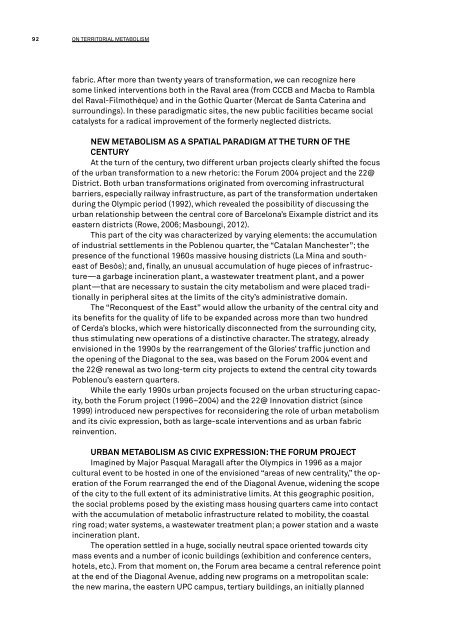DESIGNING TERRITORIAL METABOLISM
978-3-86859-489-8 https://www.jovis.de/de/buecher/product/designing_territorial_metabolism.html
978-3-86859-489-8
https://www.jovis.de/de/buecher/product/designing_territorial_metabolism.html
You also want an ePaper? Increase the reach of your titles
YUMPU automatically turns print PDFs into web optimized ePapers that Google loves.
92 ON <strong>TERRITORIAL</strong> <strong>METABOLISM</strong><br />
fabric. After more than twenty years of transformation, we can recognize here<br />
some linked interventions both in the Raval area (from CCCB and Macba to Rambla<br />
del Raval-Filmothèque) and in the Gothic Quarter (Mercat de Santa Caterina and<br />
surroundings). In these paradigmatic sites, the new public facilities became social<br />
catalysts for a radical improvement of the formerly neglected districts.<br />
NEW <strong>METABOLISM</strong> AS A SPATIAL PARADIGM AT THE TURN OF THE<br />
CENTURY<br />
At the turn of the century, two different urban projects clearly shifted the focus<br />
of the urban transformation to a new rhetoric: the Forum 2004 project and the 22@<br />
District. Both urban transformations originated from overcoming infrastructural<br />
barriers, especially railway infrastructure, as part of the transformation undertaken<br />
during the Olympic period (1992), which revealed the possibility of discussing the<br />
urban relationship between the central core of Barcelona’s Eixample district and its<br />
eastern districts (Rowe, 2006; Masboungi, 2012).<br />
This part of the city was characterized by varying elements: the accumulation<br />
of industrial settlements in the Poblenou quarter, the “Catalan Manchester”; the<br />
presence of the functional 1960s massive housing districts (La Mina and southeast<br />
of Besòs); and, finally, an unusual accumulation of huge pieces of infrastructure—a<br />
garbage incineration plant, a wastewater treatment plant, and a power<br />
plant—that are necessary to sustain the city metabolism and were placed traditionally<br />
in peripheral sites at the limits of the city’s administrative domain.<br />
The “Reconquest of the East” would allow the urbanity of the central city and<br />
its benefits for the quality of life to be expanded across more than two hundred<br />
of Cerda’s blocks, which were historically disconnected from the surrounding city,<br />
thus stimulating new operations of a distinctive character. The strategy, already<br />
envisioned in the 1990s by the rearrangement of the Glories’ traffic junction and<br />
the opening of the Diagonal to the sea, was based on the Forum 2004 event and<br />
the 22@ renewal as two long-term city projects to extend the central city towards<br />
Poblenou’s eastern quarters.<br />
While the early 1990s urban projects focused on the urban structuring capacity,<br />
both the Forum project (1996–2004) and the 22@ Innovation district (since<br />
1999) introduced new perspectives for reconsidering the role of urban metabolism<br />
and its civic expression, both as large-scale interventions and as urban fabric<br />
reinvention.<br />
URBAN <strong>METABOLISM</strong> AS CIVIC EXPRESSION: THE FORUM PROJECT<br />
Imagined by Major Pasqual Maragall after the Olympics in 1996 as a major<br />
cultural event to be hosted in one of the envisioned “areas of new centrality,” the operation<br />
of the Forum rearranged the end of the Diagonal Avenue, widening the scope<br />
of the city to the full extent of its administrative limits. At this geographic position,<br />
the social problems posed by the existing mass housing quarters came into contact<br />
with the accumulation of metabolic infrastructure related to mobility, the coastal<br />
ring road; water systems, a wastewater treatment plan; a power station and a waste<br />
incineration plant.<br />
The operation settled in a huge, socially neutral space oriented towards city<br />
mass events and a number of iconic buildings (exhibition and conference centers,<br />
hotels, etc.). From that moment on, the Forum area became a central reference point<br />
at the end of the Diagonal Avenue, adding new programs on a metropolitan scale:<br />
the new marina, the eastern UPC campus, tertiary buildings, an initially planned


















